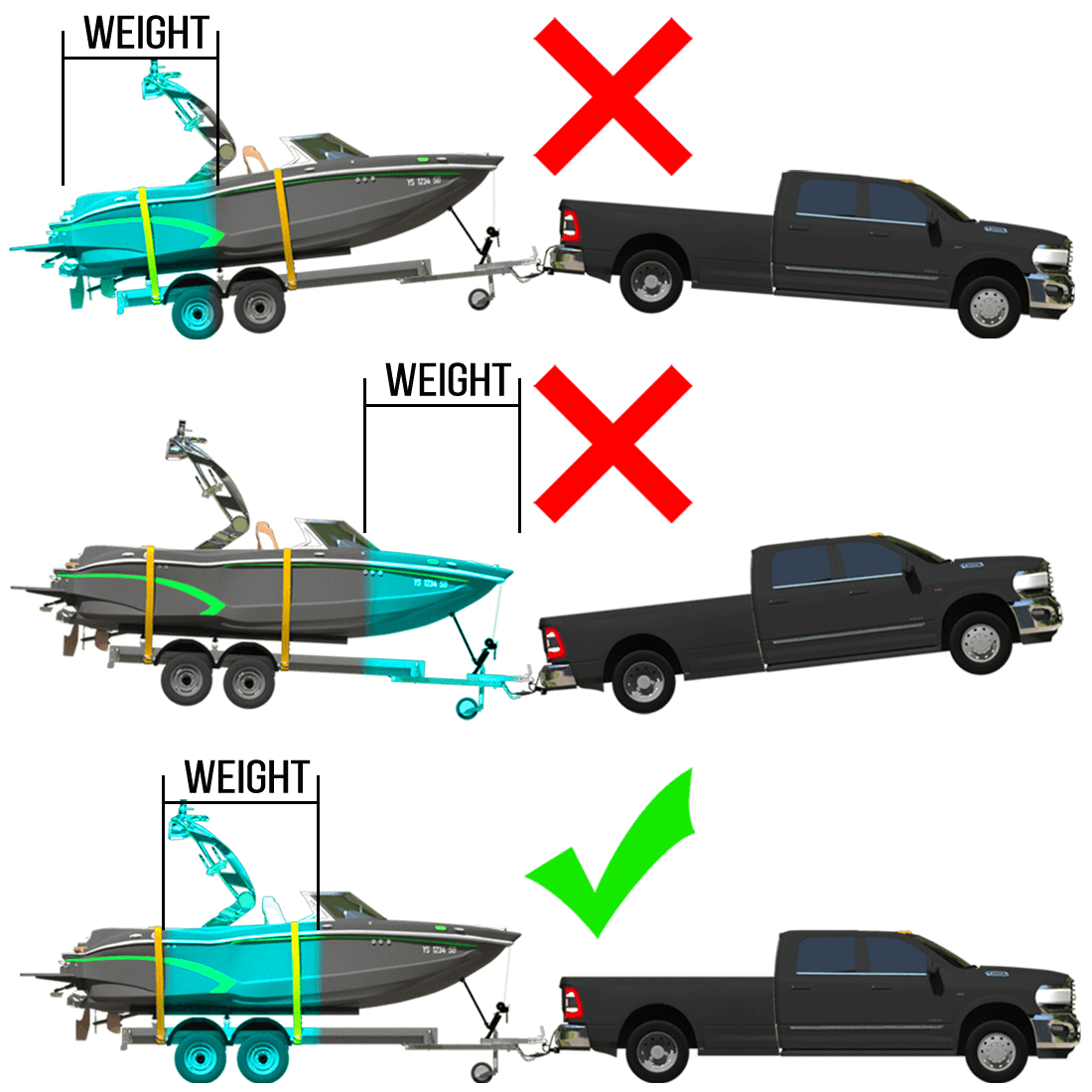What do I need to know about towing a boat?
The majority of recreational boats in the United States are trailered to and from the water. Your boat trailer is only one part of the entire boating package, which includes the boat, trailer, hitch and towing vehicle. Neglecting the trailer’s maintenance can result in damage to your boat, your towing vehicle, or both.
Trailer Capacity Plate
The trailer must have a load capacity adequate to carry the boat, motor, fuel and all equipment which may be carried in the boat as it is trailered. By law, trailers are classified by the maximum amount they may weigh when fully loaded. It is highly suggested that you never exceed 85% of a trailer's total capacity.
Gross Vehicle Weight Rating (GVWR)
- Class 1 - GVWR to 2000 lbs. (suggest 1700)
- Class 2 - GVWR to 3500 lbs. (suggest 2975)
- Class 3 - GVWR to 5000 lbs. (suggest 4250)
- Class 4 - GVWR + 5000 lbs. (suggest 85%)
Your trailer will also have a Gross Axle Weight Rating (GAWR), which is used to describe the minimum tire rating needed for that load. It must be at least equal to the GVWR.
All these numbers, plus trailer identification number, are on a capacity plate.

What is the best vehicle for towing your boat?

Another very important item to consider is the towing vehicle. It also must meet certain performance standards such as engine power, engine cooling, transmission cooling, wiring, brakes, battery, suspension, alternator, axle ratio, tires, and wheels in order to tow the boat and trailer. You should consult your dealer for advice. Each tow vehicle also has a maximum weight that it may pull by law. Again, it is suggested that you not pull more than 85% of the vehicle's limit.
Which percent of the gross trailer weight should be placed on the tongue of a boat trailer?
The ideal tongue weight should be approximately 10% of the overall weight of the boat and trailer combined.
The trailer is attached to the towing vehicle by a trailer hitch. A socket on the front of the trailer drops over a ball on the back of the hitch and then locks down. These two parts must match in size. The ball size is determined by the class of trailer. The hitch should be permanently attached to the towing vehicle and should handle the load you are attempting to pull. Bumper hitches (attached to bumper only) are illegal in some states and not recommended. The chains for the trailer hitch should be crossed under the trailer tongue.

-
Too much weight on the rear of the trailer will cause the trailer to fishtail and may reduce traction or lift the rear wheels of the tow vehicle off the ground.
-
Too much weight on the hitch will cause the rear wheels of the tow vehicle to drag and may make steering more difficult.
Rollers and/or pads are used to support the boat on the trailer. There should be sufficient support so as not to allow the boat to warp. You should make sure that all support surfaces are in contact with the boat at all times. Tie down straps should be used to secure the boat to the trailer both fore and aft. In addition, all fuel tanks and other equipment inside the boat should be secured so that its weight does not shift during towing.
NEVER CARRY GASOLINE TANKS IN THE TRUNK OF THE TOW VEHICLE.
How do you prepare to tow your boat safely?
-
Drain accumulated water from the boat's bilge.
-
Lower the tongue socket onto the ball on the trailer hitch and lock together securely.
-
Connect trailer lights to towing vehicle and check turn signals, brake lights and backup lights.
-
Attach safety chains from trailer to tow vehicle securely in a criss-cross fashion.
-
Check tie-down straps and winch and cable.
-
Make sure wheel bearings run free and are properly lubricated.
-
Check tire pressure, lug nuts and test brakes.
-
Make sure to stow drain plug in the boat so any remaining water can drain and it is there when you get to the ramp.
-
Don’t forget the keys to the boat.
How do you safely pull a trailer?
The weight that you are trailing will make your towing vehicle less responsive in many respects. Speeding up, slowing down and all maneuvers will require more time to accomplish. Leave more room between you and vehicles in front of you to make sure you can stop should they brake suddenly.
Make sure your side view mirrors are large enough to provide an unobstructed rear view on both sides of the vehicle.
Remember that the turning radius is much greater. Curbs and barriers must be given a wide berth when you turn corners. Backing a trailer can be somewhat tricky, but with practice you should be able to accomplish the task in a minimum amount of time. The trailer will turn in the opposite direction of the car; take it slowly and try to avoid oversteering. Prior to operating on the open road, practice turning, backing up, etc. on a level, empty parking lot.
